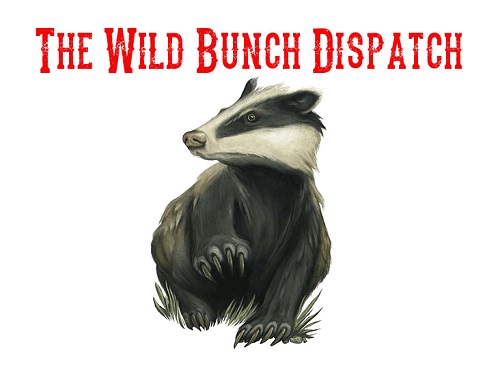
The Q&A portion of the Wild Bunch Dispatch will be held on this page from 6:30pm to 8pm (Mountain Time) today. Any questions you might have on the 70th issue (Food Sustainability When All The Stores Are Empty) please post here and I will try to answer them to the best of my ability. Some ground rules:
1) Please stick to the subject matter of the newsletter.
2) This is not a debate forum. If you have some concerns I’m happy to address them, but I can’t get into a long circular debate while other people have questions.
3) If I do not respond to your question immediately, don’t freak out. I’ll get to it, don’t worry.
4) Try to keep to one or two questions each time you write a post. Please refrain from essay-long multi-question posts. It is much appreciated.
I will begin discussion at exactly 6:30pm Mountain time. Looking forward to your questions and thoughts on the Wild Bunch Issue #70. If you missed out on this discussion you can still subscribe for the next issue and participate. For more information on how to subscribe, visit the link HERE.
Regards,
Brandon Smith, Founder of Alt-Market.us




Discussion on Issue #70 is now open.
I second potatoes. Depending on where one lives the varieties available in the store may not grow well. I live in the southeast and russet potatoes, while high yielding under favorable conditions, are poor producers due to the heat. Varieties like Kennebec, goldrush, and red la soda (to name a few) are the most resilient in hot areas.
Yes, you definitely have to adjust growing plans to your unique climate, which is something I did not mention in the newsletter. You can read up on what grows best for your region but it’s really all a matter of trial and error. I have to warn people that your first year garden will probably not turn out too good as far as production, and you really need to be growing and building up soil for three years before you start to see solid results. START NOW! Don’t wait until a supply chain collapse before you start testing out crops.
One of the best indicators of what grows in each area is the USDA Plant hardiness zones for the area you live in.Don’t waste time and money buying what will not grow in your area. Is it too cold or too hot a climate and what is the best to plant for your zone?
Know your growing zone! USDA hardiness zones—also known as planting zones or growing zones—help gardeners understand which plants can survive their region’s climate. Learn why it’s so important, how to use your zone, and find your zone on the map.
Start building good soil now so you have plenty of earthworms in your soil when spring planting comes around. “Plant” your kitchen waste – I put coffee grounds, tea bags, veggie/fruit peelings,
used paper towels – if it comes from the earth, it goes back into the earth. Farm animal manure is good to add and let it “steep” in the soil for awhile well before planting seeds. When you put your shovel into the soil and come up with a shovel of earthworms – its good to go!!
https://www.almanac.com/what-are-plant-hardiness-zones
https://www.almanac.com/gardening/growing-guides
https://www.rareseeds.com/
https://www.botanicalinterests.com/
Always buy Heirloom/Open Pollinated seeds and save your seeds from year to year. Save the best of the vegetable or fruit for the seeds. These seeds grow true to form and can be passed down from generation to generation. Hybrid seeds do not regrow true, if at all. They are a waste of time and money.
Where I live we got a lot of mesquite trees and prickly pear cactus. Both grow like weeds out here. Mesquite beans can be made into jelly, roasted and ground into coffee(made some one time; has a nice nutty flavor) or even ground into flour. And both the pads and fruits of prickly pears are edible, though the fruits have a lot of seeds and the juice can stain clothes.
That’s definitely an option as long as there’s not too many people trying to forage in the same area you are. I recommend a combination of growing produce, keeping some animals like chickens as well as forage as long as it is close to where you live. Add all this to a stockpile of stored foods and you should be able to survive comfortably enough as long as you have a steady water source.
What watering method do you use? I’ve been trying to use irrigation hoses with emitters, I wonder if they will clog up from the hard water in my area. I’m not so sure they’ll be that good in the long haul, we’ll see.
I tried some very small, short & narrow hand dug irrigation ditches, never again. Or, I did it wrong?
Watering with a simple garden hose & water cans is too time consuming & wears a person out fast when there’s drought conditions. At least for me that was the case.
If you want to use the irrigation method I would use trickle hoses. I’ve never had them clog. I prefer heavy duty sprinklers on T-posts. I draw water using a pump and a natural water source. You could also use 50 gallon drums with water from your rain gutters and pump it into the garden. I would look into any method that does not rely on grid water.
If you remove your drip emitters/ irrigation from the soil growing area, they can be effectively cleaned with distilled vinegar (just don’t add the acid to your growing area)
RE: “If you remove your drip emitters…”
Yes, of course. True.
What I wonder is, how long will the hose hold up pulling those out & putting them back in? I can imagine the emitters may just pop out over time as the hole,… expands? I just don’t have the experience with them, yet, to say.
Plus, with a big garden, that’s a fairly time consuming task.
Nothing worth having is easy, though.
Certainly not easy but rewarding.
Like Brandon said soakers are great to and pretty easy to manage.
I personally like using soakers , spay heads and drip emitters under different zones and area’s of the garden. The emitters are super cheap and could be replaced (while supplies last). The heads usually have nozzles that can also be replaced. I pull my soaker hoses every fall to preserve their life span. The rest of the irrigation is treated similarly to a typical lawn set up, blowing it out prior to winter, maintaining it etc. Design redundancy into your design just in case a watering can and natural rainfall end up being your only option. The Vegetable Gardners Bible is my favorite book and I’ve had great success using it.
Happy Gardening
Keep in mind I live in town on a small lot at high elevations (9500ft) and can supplement my food supply pretty well. We hope to move to a fully sustainable property in the near future but we do what we can with what we have right.
On the topic of black markets, one practice that should never be tolerated is human trafficking. I recommend destroying such operations with extreme prejudice.
Some black market operations will be essential, but others should be shut down wherever they arise.
I believe the best way to prioritize what to grow is by breaking it down into macronutrients(fat, protein, and carbohydrates) and micronutrients(vitamins and minerals) as well as the amount of time it takes to tend to the crop and storage potential. With this in mind here are a couple key crops I believe should be planted in the growing region I live in (southeast). I will leave out potatoes and dandelions since the newsletter covered those. 1. Amaranth. If you got nothing from this comment take this. I haven’t encountered a more drought and heat tolerant crop than this. Thus it takes very little maintenance. The seeds are higher in protein than quinoa and just denser nutritionally in general. It has a higher fat content than most grains. It stores up for a year. All three macronutrients are met and it is rich in minerals. 2. Winter squash. Both the fruit and seeds are edible. The fruit has vitamin A and the seeds are rich in fat with some protein. Where I live only butternut squash and Seminole pumpkin grow because of pests. The latter has the longest shelf life of 1 year although it is best consumed within 6 months.
Another thing which I forgot to mention in the newsletter is the importance of bees. When I set up my first survival garden many years ago the area was mostly timber which I had to clear. There were very few bees and I did not account for that. A lot of my plants flowered but did not go to fruit because of this. My solution was to plant red and white clover all around the property and around the outside of the garden fence. There have been massive amounts of bees ever since. You need a large amount of flowers to attract bees and convince them to build a hive nearby. The other option is to keep bees yourself, which is great if you can keep them alive and collect the honey. Another trick I use to keep pests away from the crops is to let the chickens roam freely around the outside of the garden fence. Chickens eat EVERYTHING, from bugs to mice. I’ve never had a problem with pests in my garden.
For what chickens may be ducks are that on steroids when it comes to foraging for their own food. Thus they take less feed. They also suffer less from disease and tolerate being wet. Don’t take my word for it. A basic Google search confirms what I’m staying. I personally would raise ducks before chickens.
I don’t like the taste of duck eggs, ducks are meaner than chickens, and they tend to prefer a standing water source like a pond. Chickens are working great for me so I doubt I will switch.
RE: “ducks are meaner”
Add guinea to that list. I had two, they got along great with the hens they grew up with. Then, I introduced some new hens & the guinea pecked at the new hens, pulled their back feathers & did some real damage to the new hens. I doubt I’ll ever have guinea again.
I’ve also heard that duck meat had greasy texture.
Brandon – For DIY breeding bees in plastic bottles and kegs, this video is an absolute must watch — what this guy did by himself is awesome for beekeeping & making honey: https://www.youtube.com/watch?v=9ItlOFLTUAs
Chicken manure is good to build up the soil. It remains “hot” for awhile so its good to let it “ruminate” in the soil awhile before planting.
I also plant lots of clover and and bee-attracting flowers in with the veggies and fruit trees for the bees and other pollinators. Rosemary is excellent. But keep it corralled in an area as so it doesn’t get out of hand.
Never plant mint or morning glories anyplace but in a pot as they can easily take over a garden and never leave!!
Discussion is now closed on Issue #70. Thanks to all those subscribers who participated. If you missed out on this issue or would like to subscribe to The Wild Bunch Dispatch to receive future issues, visit the subscription page HERE.
Issue #71 will be released in two weeks.